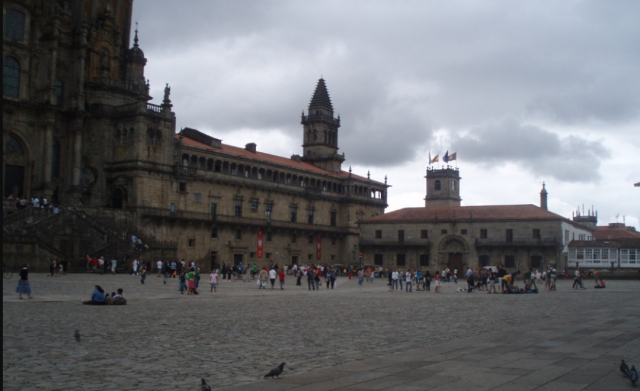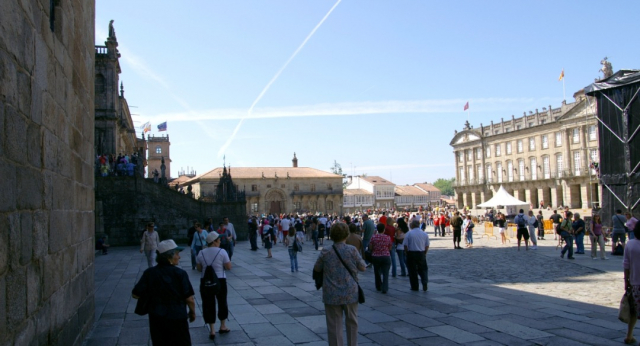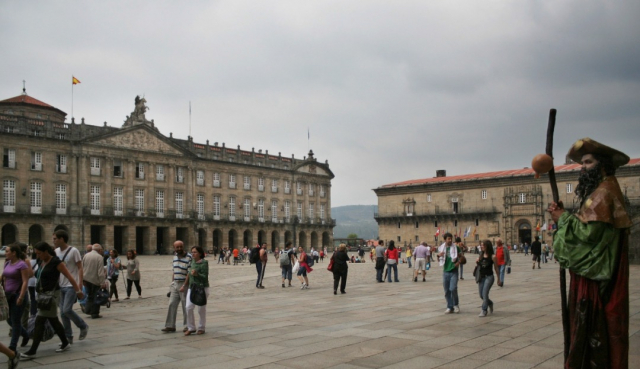Why can't you come to drink in the Plaza del Obradoiro?
The Plaza del Obradoiro is an icon on the Camino de Santiago, the place where the pilgrimage ends and therefore we should all take care of it.
The historical essence of Plaza del Obradoiro
The Plaza del Obradoiro is the beating heart of Santiago de Compostela, it is not just a wide cobbled space surrounded by majestic buildings. It is, above all, a setting that has witnessed innumerable historical moments, celebrations and, above all, the end of the spiritual journey of thousands of pilgrims who walk the Camino de Santiago every year. This square, whose name comes from the term "golden work", reflects the majesty of the baroque art of the facade of the cathedral that presides over it with the same name.
If you walk around its contours, you will feel how each stone and each corner narrate centuries of stories, legends and traditions . It is not difficult to imagine the voices of the stonemasons who brought these buildings to life, or the whispers of the pilgrims exhausted but overflowing with joy at the end of their journey. The square, in its silence, speaks of a cultural and spiritual heritage that has been passed down from generation to generation.
For this reason, Plaza del Obradoiro is not just a tourist spot or one more stop on an itinerary. It is a living tribute to history, faith and tradition. It is the heart of a city that has been, and continues to be, a meeting point for people from all over the world, uniting cultures, beliefs and hopes in a single shared space.
Regulations in the Plaza del Obradoiro
The preservation of historical and cultural heritage is essential to guarantee that future generations can appreciate and understand the richness and meaning of emblematic places such as Plaza del Obradoiro. It is within this framework that specific regulations have been established to protect it. One of the most notable is the prohibition of eating and drinking within its limits, a regulation that may surprise some, but whose primary purpose is to maintain the integrity of the space.
This type of regulation is not exclusive to Santiago de Compostela. Many historic sites around the world have taken similar steps to protect their heritage. The reason is simple: consumption of food and drink can lead to forgotten waste, accidental spills and other incidents that, in the long term, can damage the pavers , stain the hundred-year-old stones or simply detract from the beauty and solemnity of the place.
It is important that both locals and visitors understand and abide by these regulations. After all, these are measures designed to ensure that Plaza del Obradoiro continues to be that majestic meeting point, full of stories that it has been for centuries. By refraining from consuming within its confines, we are not only fulfilling a rule, but also paying homage to a space that symbolizes the confluence of faith, history, and culture.
More Than Pavers: The Reason Behind Conservation
When we think about conservation, we often imagine large restoration works or complex interventions. However, conservation is also found in small gestures, in the daily decisions we make when visiting heritage spaces such as Plaza del Obradoiro. The seemingly innocent act of eating or drinking can have unintended consequences for the environment: from crumbs that attract birds and other animals, to spills that stain and erode historic pavers.
These details, which may seem small at first, add up over time. The accumulation of debris, for example, can affect the local ecosystem, and stains and wear on the stone can require expensive and complex restorations. The ban on eating and drinking is, in essence, a preventive measure, designed to prevent damage that, once occurred, may be irreparable or very difficult to remedy.
Respecting and caring for places like Plaza del Obradoiro is everyone's responsibility. By understanding the reasons behind these regulations, we are not only more aware of our actions, but also actively contribute to preserving a treasure that has stood the test of centuries and deserves to be admired by future generations.
Respecting the end of the Camino: The sacred character of the Obradoiro
Plaza del Obradoiro is not simply an open space surrounded by impressive architecture; it is a spiritual meeting point that has touched the hearts of countless pilgrims throughout the centuries. It is the end of the Camino de Santiago, a journey that many undertake not only for sport or tourism, but also as a spiritual pilgrimage. When those travelers arrive at the plaza, it is a time of reflection, gratitude, and often deep spiritual connection.
Eating and drinking, although they are daily and human acts, can break the atmosphere of contemplation and respect that characterizes this sacred place. Imagine arriving after a long trip, looking for that moment of stillness and finding yourself, and finding yourself in the middle of a picnic. The contrast could be shocking and dissonant with the essence of the place.
For this reason, we have sought to maintain the Obradoiro as a space of respect, not only towards history and heritage, but also towards the spiritual dimension that it represents for many. By refraining from mundane activities such as eating or drinking, we allow this space to remain a haven of serenity and reflection for all who visit with hearts full of hope, faith, and gratitude.
Routes
Blog
 ¿Vas a hacer el camino de Santiago? Cuida tus pies antes y después
¿Vas a hacer el camino de Santiago? Cuida tus pies antes y después
 5 razones por las que contratar un seguro de viajes
5 razones por las que contratar un seguro de viajes
 Formas de hacer un logotipo
Formas de hacer un logotipo
 La importancia del registro de llamadas durante tu viaje por el Camino de Santiago
La importancia del registro de llamadas durante tu viaje por el Camino de Santiago
Information
Points of interest
Cities & Towns | Hostels | Lodgings | Restaurants | Saddlery | Doctors | Points of interest | Bikes workshop
Contact us | Privacy policy | Cookies policy | | Terms of use | Authorship | Web Map | Consentimiento
© Copyright LA VOZ DE GALICIA S.A. Polígono de Sabón, Arteixo, A CORUÑA (ESPAÑA) Inscrita en el Registro Mercantil de A Coruña en el Tomo 2438 del Archivo, Sección General, a los folios 91 y siguientes, hoja C-2141. CIF: A-15000649


